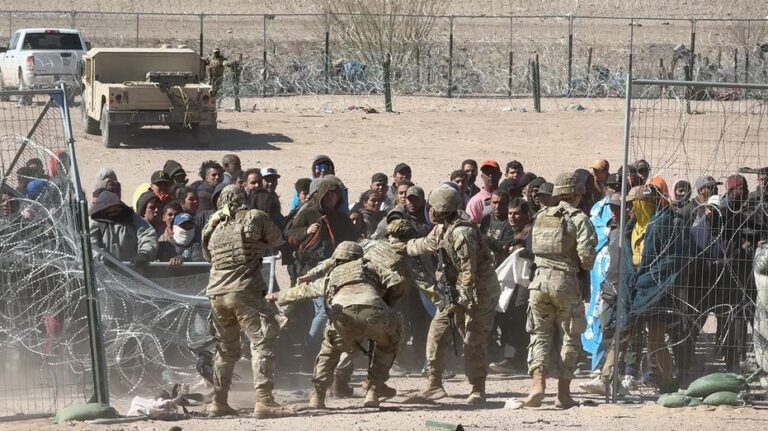
For nearly 14 years, Bashar al-Assad’s regime pursued a maniacal campaign of brutality against its own people, in order to suppress opposition through terror and mass killing. Beginning very early on, Assad’s military and security apparatus embraced what they called an “Assad or we burn the country” approach – but in truth, it was more Assad and we burn the country.
At least 500,000 Syrians have since been killed, more than 130,000 more disappeared into a mass detention, torture and execution infrastructure in which industrial crematoriums and “iron presses” were used to efficiently dispose of bodies. From 2012 to 2016, 82,000 barrel bombs were dropped indiscriminately on urban areas of Syria, and nearly 340 verified chemical weapons attacks directed at civilian communities. Sunni Muslim villages were attacked and their entire population massacred, often with hammers and axes for terrifying effect. With such horrors in mind, the recent overthrow of Assad is a cause for extraordinary relief and celebration, though the challenge of turning that euphoria into long-term stability will prove a challenge.
On Sunday, President Biden declared that “at long last, Assad’s regime has fallen.” While there is no doubt that Biden will be glad to see the back of Assad, his administration was, until just days ago, exploring a potential deal that would have eased sanctions on his regime.
HERE IS WHO IS VYING FOR POWER IN SYRIA AFTER THE FALL OF BASHAR AL-ASSAD
Notwithstanding the morally abhorrent nature of such a proposal, the fact that it was being considered at all was reflective of a long-standing miscalculation around Syria that has predominated for years: the idea that the conflict was frozen, Assad had won and his long-term survival was inevitable.
This reflected a fundamental misunderstanding of Syria and the consequences of events there year-on-year since 2011. It was also the consequence of a deep-seated fatigue and cynicism with the issue and a desire to simply move on. It was under the first Trump administration that the demand for Assad’s removal was removed in favor of “behavioral change” and under Biden, Syria virtually vanished from being anywhere near an issue worthy of any meaningful effort.
While the lines on Syria’s map may not have changed since 2020, hostilities in the country had been steadily escalating for some time. With Russian assistance, Assad’s regime had begun a suicide drone campaign on civilian communities in northwest Syria in late-June that saw 467 such devices launched in five months. Indiscriminate artillery shelling had been increasing monthly since the summer too. Meanwhile, the economic and humanitarian crisis in Syria has been worse than ever, while international assistance to respond with aid has declined sharply.
THE RISE AND FALL OF BASHAR AND ASMA ASSAD
With Syria’s people on all sides suffering more than ever, Assad’s refusal to constructively engage with and meaningfully benefit from the decision by Arab governments to normalize their ties with him in 2023 engendered increasing frustration on the street. Assad’s subsequent refusal to pragmatically engage with Turkey’s offer of normalization in 2024 arguably set the conditions for his regime’s rapid collapse late this year.
Ultimately, if any international attention had remained focused on Syria, it was directed towards symptoms of the crisis, such as ISIS and refugees. Concerted international efforts to deal with such symptoms had come to dominate policy, while the root cause and most prominent driver of the crisis itself – Bashar al-Assad’s regime – was dismissed as irresolvable.
While channeling resources towards challenges like fighting ISIS is perfectly justifiable and necessary, the consistent reality inside Syria was that Assad’s regime was the actor responsible for triggering all the destabilizing effects – from terrorism, to displacement, multiple wars, and more. In fact, at least 90% of all documented civilian deaths in Syria since 2011 were the result of attacks by the regime and its Russian and Iranian allies. ISIS by contrast has been responsible for just 2%.
Simple facts like this explain why things collapsed so dramatically and quickly in Syria in recent days. Assad’s regime had not won anything and Syria’s people were reaching their breaking point.
CLICK HERE FOR MORE FOX NEWS OPINION
The regime itself had been decaying for years, riven by internal division and the effects of organized crime, which had infiltrated virtually every corner of power. In regions of the country that had previously been controlled by the opposition, gunmen began turning on the regime in 2024, eroding regime authority with increasing effect. Minority groups were calling for Assad’s downfall, and the armed opposition in the northwest were preparing for a fight. All of this was happening in the open, but policymakers did not want to do the math and acknowledge what it meant: that Assad was weaker and more vulnerable than ever.
For this reason, the recent dramatic developments in Syria caught the U.S. and its allies completely flat-footed. With the Biden administration now in its last weeks, there is also only so much it can do to respond. For now, in concert with allies and partners in the region, it must surge its engagement with actors on the ground to shape what comes next.
Urgent steps are required to protect our SDF partners in northeast Syria, who are under unprecedented pressure both from within their ranks, as well as from Turkey. Left unresolved, the crisis facing the SDF risks triggering a sudden need for U.S. troops to withdraw from Syria altogether. The U.S. troop deployment in the northeast remains vital to the ongoing campaign against ISIS and to the securing of prisons and camps containing more than 50,000 men, women and children associated with the terror group.
Significant uncertainty persists about where the incoming Trump administration will stand on Syria, with Trump clearly indicating his long-standing instinct that Syria matters little, if at all to the U.S.
Given the profound changes underway, and the huge blow they have dealt to Iran, such a calculation would be a serious error of judgment and some of his national security appointees know it.
For nearly 14 years, Bashar al-Assad’s regime pursued a maniacal campaign of brutality against its own people, in order to suppress opposition through terror and mass killing. Beginning very early on, Assad’s military and security apparatus embraced what they called an “Assad or we burn the country” approach – but in truth, it was more Assad and we burn the country.
At least 500,000 Syrians have since been killed, more than 130,000 more disappeared into a mass detention, torture and execution infrastructure in which industrial crematoriums and “iron presses” were used to efficiently dispose of bodies. From 2012 to 2016, 82,000 barrel bombs were dropped indiscriminately on urban areas of Syria, and nearly 340 verified chemical weapons attacks directed at civilian communities. Sunni Muslim villages were attacked and their entire population massacred, often with hammers and axes for terrifying effect. With such horrors in mind, the recent overthrow of Assad is a cause for extraordinary relief and celebration, though the challenge of turning that euphoria into long-term stability will prove a challenge.
On Sunday, President Biden declared that “at long last, Assad’s regime has fallen.” While there is no doubt that Biden will be glad to see the back of Assad, his administration was, until just days ago, exploring a potential deal that would have eased sanctions on his regime.
HERE IS WHO IS VYING FOR POWER IN SYRIA AFTER THE FALL OF BASHAR AL-ASSAD
Notwithstanding the morally abhorrent nature of such a proposal, the fact that it was being considered at all was reflective of a long-standing miscalculation around Syria that has predominated for years: the idea that the conflict was frozen, Assad had won and his long-term survival was inevitable.
This reflected a fundamental misunderstanding of Syria and the consequences of events there year-on-year since 2011. It was also the consequence of a deep-seated fatigue and cynicism with the issue and a desire to simply move on. It was under the first Trump administration that the demand for Assad’s removal was removed in favor of “behavioral change” and under Biden, Syria virtually vanished from being anywhere near an issue worthy of any meaningful effort.
While the lines on Syria’s map may not have changed since 2020, hostilities in the country had been steadily escalating for some time. With Russian assistance, Assad’s regime had begun a suicide drone campaign on civilian communities in northwest Syria in late-June that saw 467 such devices launched in five months. Indiscriminate artillery shelling had been increasing monthly since the summer too. Meanwhile, the economic and humanitarian crisis in Syria has been worse than ever, while international assistance to respond with aid has declined sharply.
THE RISE AND FALL OF BASHAR AND ASMA ASSAD
With Syria’s people on all sides suffering more than ever, Assad’s refusal to constructively engage with and meaningfully benefit from the decision by Arab governments to normalize their ties with him in 2023 engendered increasing frustration on the street. Assad’s subsequent refusal to pragmatically engage with Turkey’s offer of normalization in 2024 arguably set the conditions for his regime’s rapid collapse late this year.
Ultimately, if any international attention had remained focused on Syria, it was directed towards symptoms of the crisis, such as ISIS and refugees. Concerted international efforts to deal with such symptoms had come to dominate policy, while the root cause and most prominent driver of the crisis itself – Bashar al-Assad’s regime – was dismissed as irresolvable.
While channeling resources towards challenges like fighting ISIS is perfectly justifiable and necessary, the consistent reality inside Syria was that Assad’s regime was the actor responsible for triggering all the destabilizing effects – from terrorism, to displacement, multiple wars, and more. In fact, at least 90% of all documented civilian deaths in Syria since 2011 were the result of attacks by the regime and its Russian and Iranian allies. ISIS by contrast has been responsible for just 2%.
Simple facts like this explain why things collapsed so dramatically and quickly in Syria in recent days. Assad’s regime had not won anything and Syria’s people were reaching their breaking point.
CLICK HERE FOR MORE FOX NEWS OPINION
The regime itself had been decaying for years, riven by internal division and the effects of organized crime, which had infiltrated virtually every corner of power. In regions of the country that had previously been controlled by the opposition, gunmen began turning on the regime in 2024, eroding regime authority with increasing effect. Minority groups were calling for Assad’s downfall, and the armed opposition in the northwest were preparing for a fight. All of this was happening in the open, but policymakers did not want to do the math and acknowledge what it meant: that Assad was weaker and more vulnerable than ever.
For this reason, the recent dramatic developments in Syria caught the U.S. and its allies completely flat-footed. With the Biden administration now in its last weeks, there is also only so much it can do to respond. For now, in concert with allies and partners in the region, it must surge its engagement with actors on the ground to shape what comes next.
Urgent steps are required to protect our SDF partners in northeast Syria, who are under unprecedented pressure both from within their ranks, as well as from Turkey. Left unresolved, the crisis facing the SDF risks triggering a sudden need for U.S. troops to withdraw from Syria altogether. The U.S. troop deployment in the northeast remains vital to the ongoing campaign against ISIS and to the securing of prisons and camps containing more than 50,000 men, women and children associated with the terror group.
Significant uncertainty persists about where the incoming Trump administration will stand on Syria, with Trump clearly indicating his long-standing instinct that Syria matters little, if at all to the U.S.
Given the profound changes underway, and the huge blow they have dealt to Iran, such a calculation would be a serious error of judgment and some of his national security appointees know it.



